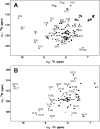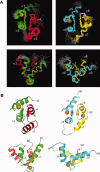Nuclear magnetic resonance structure of calcium-binding protein 1 in a Ca(2+) -bound closed state: implications for target recognition
- PMID: 21608059
- PMCID: PMC3189521
- DOI: 10.1002/pro.662
Nuclear magnetic resonance structure of calcium-binding protein 1 in a Ca(2+) -bound closed state: implications for target recognition
Abstract
Calcium-binding protein 1 (CaBP1), a neuron-specific member of the calmodulin (CaM) superfamily, regulates the Ca(2+) -dependent activity of inositol 1,4,5-triphosphate receptors (InsP3Rs) and various voltage-gated Ca(2+) channels. Here, we present the NMR structure of full-length CaBP1 with Ca(2+) bound at the first, third, and fourth EF-hands. A total of 1250 nuclear Overhauser effect distance measurements and 70 residual dipolar coupling restraints define the overall main chain structure with a root-mean-squared deviation of 0.54 Å (N-domain) and 0.48 Å (C-domain). The first 18 residues from the N-terminus in CaBP1 (located upstream of the first EF-hand) are structurally disordered and solvent exposed. The Ca(2+) -saturated CaBP1 structure contains two independent domains separated by a flexible central linker similar to that in calmodulin and troponin C. The N-domain structure of CaBP1 contains two EF-hands (EF1 and EF2), both in a closed conformation [interhelical angles = 129° (EF1) and 142° (EF2)]. The C-domain contains EF3 and EF4 in the familiar Ca(2+) -bound open conformation [interhelical angles = 105° (EF3) and 91° (EF4)]. Surprisingly, the N-domain adopts the same closed conformation in the presence or absence of Ca(2+) bound at EF1. The Ca(2+) -bound closed conformation of EF1 is reminiscent of Ca(2+) -bound EF-hands in a closed conformation found in cardiac troponin C and calpain. We propose that the Ca(2+) -bound closed conformation of EF1 in CaBP1 might undergo an induced-fit opening only in the presence of a specific target protein, and thus may help explain the highly specialized target binding by CaBP1.
Copyright © 2011 The Protein Society.
Figures






Similar articles
-
Structural insights into Ca2+-dependent regulation of inositol 1,4,5-trisphosphate receptors by CaBP1.J Biol Chem. 2009 Jan 23;284(4):2472-81. doi: 10.1074/jbc.M806513200. Epub 2008 Nov 13. J Biol Chem. 2009. PMID: 19008222 Free PMC article.
-
1H, 15N, and 13C chemical shift assignments of calcium-binding protein 1 with Ca2+ bound at EF1, EF3 and EF4.Biomol NMR Assign. 2010 Oct;4(2):159-61. doi: 10.1007/s12104-010-9235-8. Epub 2010 May 26. Biomol NMR Assign. 2010. PMID: 20503119 Free PMC article.
-
Chemical shift assignments of the C-terminal domain of CaBP1 bound to the IQ-motif of voltage-gated Ca2+ channel (CaV1.2).Biomol NMR Assign. 2022 Oct;16(2):385-390. doi: 10.1007/s12104-022-10108-0. Epub 2022 Sep 5. Biomol NMR Assign. 2022. PMID: 36064846 Free PMC article.
-
L-Type Ca2+ Channel Regulation by Calmodulin and CaBP1.Biomolecules. 2021 Dec 2;11(12):1811. doi: 10.3390/biom11121811. Biomolecules. 2021. PMID: 34944455 Free PMC article. Review.
-
Structure-Function Diversity of Calcium-Binding Proteins (CaBPs): Key Roles in Cell Signalling and Disease.Cells. 2025 Jan 21;14(3):152. doi: 10.3390/cells14030152. Cells. 2025. PMID: 39936944 Free PMC article. Review.
Cited by
-
Molecular dynamics of the neuronal EF-hand Ca2+-sensor Caldendrin.PLoS One. 2014 Jul 24;9(7):e103186. doi: 10.1371/journal.pone.0103186. eCollection 2014. PLoS One. 2014. PMID: 25058677 Free PMC article.
-
Structural insights into activation of the retinal L-type Ca²⁺ channel (Cav1.4) by Ca²⁺-binding protein 4 (CaBP4).J Biol Chem. 2014 Nov 7;289(45):31262-73. doi: 10.1074/jbc.M114.604439. Epub 2014 Sep 25. J Biol Chem. 2014. PMID: 25258313 Free PMC article.
-
Calmodulin Lobes Facilitate Dimerization and Activation of Estrogen Receptor-α.J Biol Chem. 2017 Mar 17;292(11):4614-4622. doi: 10.1074/jbc.M116.754804. Epub 2017 Feb 7. J Biol Chem. 2017. PMID: 28174300 Free PMC article.
-
Solution NMR structure of the Ca2+-bound N-terminal domain of CaBP7: a regulator of golgi trafficking.J Biol Chem. 2012 Nov 2;287(45):38231-43. doi: 10.1074/jbc.M112.402289. Epub 2012 Sep 18. J Biol Chem. 2012. PMID: 22989873 Free PMC article.
-
Calcium triggers reversal of calmodulin on nested anti-parallel sites in the IQ motif of the neuronal voltage-dependent sodium channel NaV1.2.Biophys Chem. 2017 May;224:1-19. doi: 10.1016/j.bpc.2017.02.006. Epub 2017 Mar 9. Biophys Chem. 2017. PMID: 28343066 Free PMC article.
References
-
- Bennett MK. Ca2+ and the regulation of neurotransmitter secretion. Curr Opin Neurobiol. 1997;7:316–322. - PubMed
-
- Burgoyne RD, Morgan A. Ca2+ and secretory-vesicle dynamics. Trends Neurosci. 1995;18:191–196. - PubMed
-
- Haeseleer F, Imanishi Y, Sokal I, Filipek S, Palczewski K. Calcium-binding proteins: intracellular sensors from the calmodulin superfamily. Biochem Biophys Res Commun. 2002;290:615–623. - PubMed
-
- Mikhaylova M, Sharma Y, Reissner C, Nagel F, Aravind P, Rajini B, Smalla KH, Gundelfinger ED, Kreutz MR. Neuronal Ca2+ signaling via caldendrin and calneurons. Biochim Biophys Acta. 2006;1763:1229–1237. - PubMed
Publication types
MeSH terms
Substances
Associated data
- Actions
- Actions
Grants and funding
LinkOut - more resources
Full Text Sources
Molecular Biology Databases
Research Materials
Miscellaneous

